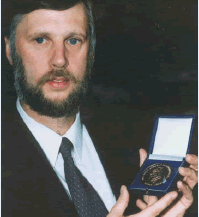| enginuity |
|
Silver Medal Awards
 Andy Hopper
FREng, Professor of Communication Engineering, has won a prestigious Royal Academy
of Engineering Silver Medal for his phenomenal record of developing and commercialising
new computing technologies.
Andy Hopper
FREng, Professor of Communication Engineering, has won a prestigious Royal Academy
of Engineering Silver Medal for his phenomenal record of developing and commercialising
new computing technologies.
The award of the Royal Academy of Engineering Silver Medal to Professor Andy
Hopper recognises "his outstanding research exploitation characterised
by imaginative innovation followed throught to practical realisation: this has
led to industrial exploitation, including some ten successful start-up operations."
He has founded or co-founded eleven start-up companies, including Acorn Computers
Ltd, where he was Research Director. After the success of its BBC Microcomputer
Acorn spawned the world-leading chip company ARM. Professor Hopper received
his medal at the Academy Awards Dinner in London on Thursday 5 June.
Professor Hopper is currently excited about one of his newest spin-offs, RealVNC
Ltd, formed last year to develop remote control software for desktop PCs. "This
one is really going against the trend," he says, "we're going back
to the old-fashioned idea of dumb terminals, which carry only graphics, linked
to a central computer that does the hard work. It burns bandwidth passing all
the instructions and graphics up and down the line but the trade-off is much
simpler programming." Five million users have downloaded over 15 million
licences for RealVNC from its open source on the web. "We're exporting
British engineering to a huge number of people all over the world, "in
its own field this is revolutionary technology but we run it with three lads
in an office in Cambridge."
The Academy's Silver Medals, instigated in 1995, are awarded annually to engineers
aged 50 or under who have made outstanding contributions to British engineering.
Only four awards may be made each year.
 Professor
Howard Hodson received a Silver Medal from the Royal Academy of Engineering
in 2001 in recognition of his 'outstanding and demonstrated personal contribution
to British engineering, which has led to market exploitation.' His research
has led to the development of a high-lift turbine which has up to 20 per cent
fewer blades and higher efficiency than previously. How is this still possible
after so many years of turbine research?
Professor
Howard Hodson received a Silver Medal from the Royal Academy of Engineering
in 2001 in recognition of his 'outstanding and demonstrated personal contribution
to British engineering, which has led to market exploitation.' His research
has led to the development of a high-lift turbine which has up to 20 per cent
fewer blades and higher efficiency than previously. How is this still possible
after so many years of turbine research?
Howard Hodson explains:
"The efficiency of Aircraft engines has risen steadily over the years, largely because of increases in the operating temperatures that can be used. However there is a trade-off between the life of components and the operating temperature so we had to look at other ways of reducing the whole life cost of the Engine. One way is to increase the efficiency of each component but this is very difficult. Another is to reduce the number of blades (currently around 1000) used in the low pressure turbine that drives the fan. Because this turbine is large and heavy this reduces not only the cost of manufacture but also the weight of the engine and therefore the cost of ownership."
"This can only be done by making each turbine blade carry a greater aerodynamic force. We managed to do this by going back to examine the fundamentals of fluid flow around the turbine blades and discovering a method of increasing the lift and efficiency which involves seeding the laminar flow around each blade with bursts of turbulence. This actually increases the amount of laminar flow in a rather subtle way. Laminar flow is needed to increase the efficiency. The problem is that laminar flow tends to detach from the blades, which means that the lift cannot be sustained. By the way, we had actually spent the previous ten years 'proving' that this was not a good idea!"
"This project was conducted in conjunction with Neil Harvey, Senior Technologist at Rolls Royce. It was this close collaboration with industry that allowed a successful outcome to the project-that and the enthusiasm and talent of a large pool of graduate students working at the Whittle Laboratory."
"So what is now the way forward? Well, there are always trade-offs in this type of work, and one of the problems of reducing the number of aerofoils in each stage of the turbine is that the engines become noisier. So the next step forward is likely to address the possibility of reducing the number of stages in jet engines, and thus achieve a further reduction in the number of component parts."
For further information, please contact Professor Howard Hodson email:hph@eng.cam.ac.uk
| number 12, summer '03 |